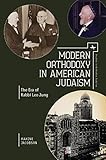Modern Orthodoxy in American Judaism : the Era of Rabbi Leo Jung.
Material type: TextSeries: Studies in Orthodox JudaismPublication details: Academic Studies Press, 2016.Description: 1 online resource (285 pages)Content type:
TextSeries: Studies in Orthodox JudaismPublication details: Academic Studies Press, 2016.Description: 1 online resource (285 pages)Content type: - 1618114387
- 9781618114389
- 296.092 23
- BM755.J86 J33 2016
- online - EBSCO
- BD 7020
| Item type | Current library | Call number | URL | Status | Notes | Barcode | |
|---|---|---|---|---|---|---|---|
 eBook
eBook
|
Biblioteca "Angelicum" Pont. Univ. S.Tommaso d'Aquino Nuvola online | online - EBSCO (Browse shelf(Opens below)) | Online access | Not for loan (Accesso limitato) | Accesso per gli utenti autorizzati / Access for authorized users | (ebsco)1203390 |
Print version record.
Pages:1 to 25; Pages:26 to 50; Pages:51 to 75; Pages:76 to 100; Pages:101 to 125; Pages:126 to 150; Pages:151 to 175; Pages:176 to 200; Pages:201 to 225; Pages:226 to 250; Pages:251 to 261.
This work presents the issues of Modern Orthodox Judaism in America, from the decades of the twenties to the sixties, by looking at the activities of one of its leaders, Rabbi Dr. Leo Jung, pulpit rabbi, community leader and writer, whose career spanned over sixty years, beginning in the 1920s. Jung is a fulcrum around which many issues are explored. Rabbi Jung's path crossed with some of the most interesting people of his time. He worked with Chaim Weizmann, the first president of Israel, with Albert Einstein to promote Yeshiva College, with Herman Wouk, American author and Pulitzer Prize winner, and with Pearl Buck, a Nobel Prize laureate and Pulitzer Prize winner. Modern Orthodoxy went from being a threatened entity on the American scene to a well- recognized and respected force in Judaism. Orthodoxy, at first, was seen as alien to the American environment. Marshall Sklare, perhaps the most influential exponent of this notion, wrote in the 1950s that the history of Orthodoxy in America could be written in terms of a case study of institutional decay. He realized the errors of his ways in the 1970s. This is the story of the renaissance of American Modern Orthodoxy, from the disorganization of the older Orthodoxy to the new spirit of confidence that emerged after World War Two. The phenomenon of Modern Orthodoxy is examined in the context of Orthodox invigoration and change. This book has relevance for further studies in various areas. It is part of the study of religious acculturation, of the conflict between tradition and modernity and of religious reinvigoration in a secular society.


